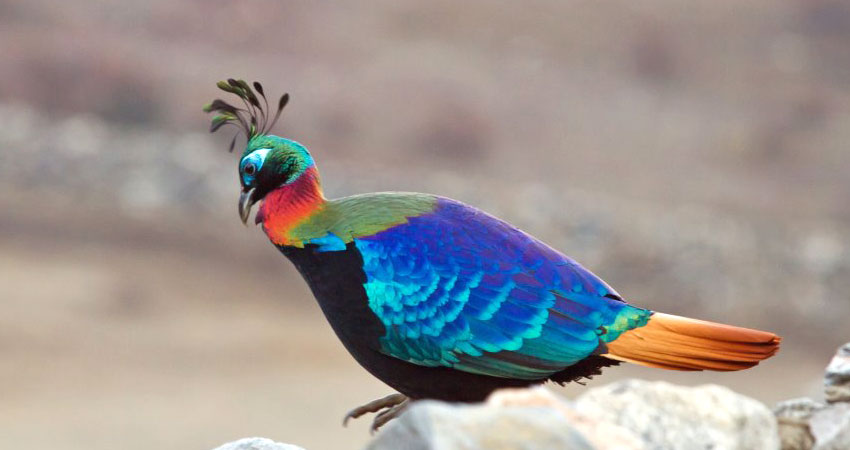“Danphe” The National Bird Of Nepal – Himalayan Monal, the Largest Bird

Nepal is a country of cultural and natural attributes. The rich artistic and beauty of Nepal are famous worldwide. Mount Everest is the highest mountain in the world, and it is in Nepal. It is the top destination for adventure geeks. In addition to this, people love to explore around Annapurna Base Camp, Everest Base Camp, Pokhara Tour, Chitwan Tour, and many more. Nepal is unique in culture and tradition as it is the only country in the world with a non-rectangular flag. Nepali people believe in peace and unity; the national bird of Nepal is Daphne.
The national bird of Nepal, Daphne, is a Nepalese word for Himalayan Monal. Danphe is found in the Himalayan region of Nepal and is a sign of peace and beauty. This bird is an inhabitant at 2100 to 4500 from sea level. Danphe is an attractive bird with a multicolored body. This bird adds beauty to the high snow-capped Himalayas. Danphe is the native bird in the Himalayan and other colder regions.
The male and female species of Himalayan Monal are different in appearance and characteristics. Male Daphne has vibrant purple, blue, green, and red feathers. The underside of their body is brown, and their trail has a patch of Beautiful feathers. On the other side of their head, they have a crown-like structure.
Both male and female Daphne have colorful eyes. The national bird of Nepal, Danfe, has an overall brown-looking look with shining Blue and Green colors. Their feather color depends on their species. However, most have white and black stripes. Female Himalayan Monal has a whitish throat compared to the male Himalayan Monal.
The male and female Species
According to the studies, the Himalayan Monal is a mixture of 12 different shining colors, while the female Daphne is a bit duller and has a browner complexion. Danphe in Nepal is seen primarily searching for food or dancing during spring. Himalayan monals are called excellent diggers, generally digging 5 – 10 inches deep in the ground. If you see them in wildlife conservation or national parks, you will mostly find them in small groups or in Paris.
Earlier, people searched and hunted these birds for their beautiful looks and food. However, hunting Danphe has been illegal for ages; concerned authorities have been awakening people about awareness and their protection.
The structure of the Himalayan Monal is unique, as is its large size. Generally, these birds are about 70cm in length. The national bird of Nepal, the male Danphe, can weigh up to 2,380 grams, and the female can weigh up to 2,150 grams. The adult birds seem very attractive, with vibrant and shining colors.
The unique characteristics of these birds are their spectacular metallic green crests and long coppery feathers. People of the Himalayan region in Nepal say that Himalayan monks dance with their features open when their feathers open. The prominent white rump is only seen when the feathers are wide open. Their feathers are directed towards the end with the uniform rufous. The lower part of their tail is whitish of the female Monal and darker of the male Monal.
Distribution of Himalayan Monal in Nepal
Himalayan Monal is mainly inhabited in the colder regions. The mountain regions of Nepal and India are the top spots where they can be found. Some of their species are also widely found in Afghanistan and Pakistan. Other than this, fewer species are found in other countries like Tibet and Bhutan. These birds have different meanings in Nepal; they are beautiful and peaceful. These birds reflect the calm behavior of the Nepali people.
Danfe mostly live in temperate oak coniferous forests, where they can find food. Danphe can also live on grassy slopes with cliffs and meadows. To sustain their lives, they must have 2400 and 4500 meters altitudes. Since the temperature decreases at the higher altitudes in the winter season, they descend to the lower altitudes.
Himalayan Monal
The scientific name of Himalayan Monal is Lophophrous Impejanus. Research shows that Danphe comes from the Galliformes family. They live in the alpine, subalpine, and coniferous forests and prefer steep grassy and open rocky slopes during winter. At the same time, they transfer to the adjacent forest during the summer season for the rhododendron. In the Himalayan region, they are in warmer places during winter and snowfall seasons. These birds are Polugamous Inneature, i.e., a male is seen with multiple females.
Danphe is very shy and quiet, so if you see them, do not make noise. The noise from the outside might scare them. In general, Himalayan Monal can remain in the same spot for over an hour. They dig a hole in the ground and spend most of their time in that hole.
They start digging a hole in the early morning and enjoy laundering the same hole for the rest of the day. This bird feeds on the trees through insects like mosquitoes and grasshoppers. Male birds are mainly seen while digging the ground, and females are chiefly dancing. Monals are vegetarian, so they eat grasses, seeds, berries, mosses, insects, and grubs.
May and June are the critical time of the year for these birds. During this month, Monal starts laying eggs under the boulders. Generally, a female Daphne can lay up to 4 – 6 eggs at a time. It takes about a month to lay eggs in a nest of rocks, bush, and some simple scrape under, making a hole in a large tree. Many species of Daphne also widely live in Myanmar
It is found throughout the country.
Danfe is widespread throughout Nepal. During the summer, they move up to 4750 meters from the sea level, whereas during the winter, they move down to 2500 meters. Makalu Barun, Sagarmatha, Langtang, Shey Phoksundo, Khaptad, and Rara National Parks; Dhorpatan Hunting Reserve; Kanchenjungha, Gaurishankar, Manaslu, Annapurna, and Api Nampa Conservation Areas are some of the protected areas in Nepal that protect Daphne.
People have made various efforts to protect this bird, but nowadays, the main threat to Daphne is hunting and trapping. Strict punishment is given to people hunting or trying to trap Himalayan Monal. Hunting and trapping mainly prevail during winter, when these birds are closer to human habitation. According to a recent survey, the population of Himalayan Monal is 3000 to 5000, but it is decreasing for various reasons.
Why is Daphne decreasing?
According to the official of the reserve office, this National bird of Nepal has been moving from the Himalayas to Dhorpatan. Dhorpatan is a city in Nepal with the geography of all Himal, Terai, and mountains. They also claim that scarecrows and hawks are chasing Dafne away from a different place, thus compelling the birds to move away from the forest areas. Hunting and trapping have been two primary reasons for Nepal’s decline in the Dap population. The Department of Wildlife has been taking strict actions regarding this.
According to the specialists, when Danphe is scared and wants to hide, they search for darker plans and grey weeds to hide. They are easily scared by every little thing. Danfe is peaceful, so if they notice outside activities around them, they hide instead of attacking. They also build their nest in a place where no one can reach. Generally, they are more Scarecrow and other animals. Chicks of Danfe are hatched from the eggs on the soil.
During summer and spring, male birds dance and enjoy attracting female birds. In Nepal, the month of Chait and Baishakh is the perfect time to see Dancing Danphe. During this month, they make different sounds and dance, and the female bird starts reproducing. In an earlier time, people in Nepal used to identify the arrival of the spring season when Daphne began making sounds and dancing.
Why should it be taken as the National bird of Nepal?
Danphe is the national bird of Nepal because many characteristics of Daphne are the same as the nature of the people in Nepal. Danphe’s multicolored body reflects Nepal’s multi-ethnic, multi-lingual, and multi-cultural culture. They are often found in groups, which should bring unity among the people in Nepal. Danphe is as peaceful and calm as the Nepal people. Danphe shows a harmonic and welcoming nature. This bird starts celebrating and dancing when they are happy; likewise, Nepali people celebrate signs and dance on happy and festive occasions.
Monal and Kajal are different species of Daphne found in Nepal. Usually, the life span of this kind of bird is generally 6 to 8 years. According to specialists, Daphne’s weight is 2.5 kg. There are six species of Daphne in South Asia. Out of these, three species live in Sagarmatha National Park. According to the officer of Sagarmatha National Park, most Monal and Kajal are inhabitants of this region. Although the actual number of these birds is unknown, they are in the verse of decreasing.
The feathers of Daphne are essential; they are used for any purpose. Daphne runs away if she sees other animals and outside noise. They do not walk alone. Instead, they walk and launder around in the pack. An expert says running away from other animals often causes trips and deaths.
The feathers
The feathers of Danphe are essential. Since it is the National bird of Nepal, its feathers reflect the symbol of Nepal to the world. Feathers are the symbol of peace. Poachers and different things are obtained with their feathers. In the Hindu religion, Lord Krishna placed the feathers of Danphe in his head.
For this reason, on Krishna Ashtami, children dress up using feathers. At an early age, people used feathers to write books and letters with printed letters. They dip the feathers in the ink and write with it. In addition, many people use feathers as decoration.
Frequently Asked Question
- Is Danphe on the red list?
Although Danphe is the national bird of Nepal, it is still on the verge of extinct. According to the officials, people hunt mostly male birds for the crest of head feathers. This is becoming a significant problem nowadays. Female Daphne is involved in searching for food. These birds are widespread in some places, but many have not adapted to the environment due to global warming and the changing climate. Their unique characteristic prevents them from finding new habitats for themselves. Wildlife Reserve Center has been making efforts to increase awareness and protect them.
- How do they communicate?
Himalayan Monal is often seen in packs and pairs. They communicate with each other just like a human. They are highly vocal and use various calls to communicate with different morals. Apart from this, they dance and perform other gestures to communicate. The males bob their chests and fan their feathers to impress their female mates.
Are they dangerous?
No, Himalayan Monal is not at all dangerous. They possess a lot of human character. Do not attack Himalayan monal until you mess with them. They usually mind their own business and scare easily.
- Which is the most giant bird in Nepal?
Yes, the Himalayan Monal is the most giant bird in Nepal and its national bird. It weighs about 2,350 kg and usually measures 70cm.
- Would they make a good pet?
The Himalayan Monal lives in a colder region at higher altitudes. However, like a parrot, you cannot keep it inside your home as a pet bird. However, it is amicable. It requires ample space and cannot sustain itself in the summer season, as it cannot withstand heat. Due to its extended size and dimensions, the Himalayan Monal National bird of Nepal needs plenty of shelter.
Best Price Guaranteed, Easy to change Date, Instant Confirmation
Book This Trip Have Questions?
Have Questions?Talk to Expert
Meet Mr. Purushotam Timalsena (Puru), Nepal's best trek and tour organizer, who has been working in the Himalayas for more than 24 years.
WhatsApp/Viber +977 98510 95 800











